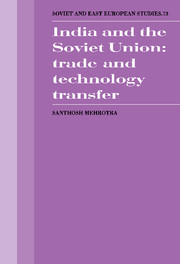Book contents
- Frontmatter
- Contents
- List of tables
- Preface
- List of abbreviations
- Introduction
- PART I
- 1 The Indian development strategy and the USSR
- 2 Indo-Soviet economic relations: geo-political and ideological factors
- 3 Soviet economic interests in non-socialist LDCs
- PART II
- PART III
- Notes
- Bibliography
- Index
- Soviet and East European Studies
1 - The Indian development strategy and the USSR
from PART I
Published online by Cambridge University Press: 04 August 2010
- Frontmatter
- Contents
- List of tables
- Preface
- List of abbreviations
- Introduction
- PART I
- 1 The Indian development strategy and the USSR
- 2 Indo-Soviet economic relations: geo-political and ideological factors
- 3 Soviet economic interests in non-socialist LDCs
- PART II
- PART III
- Notes
- Bibliography
- Index
- Soviet and East European Studies
Summary
This chapter is concerned with two questions: first, what influence the Soviet experiment with central planning had on Indian planners in the 1950s; and second, what role Soviet and east European aid played in the implementation of the Indian development strategy as identified in the Second Plan, with its marked shift in favour of capital goods industries.
The influence exercised by the Soviet planning experience was evident both in relation to the use of planning as a strategy and to the particular strategy of planning adopted in India. In 1950 history provided two examples of less developed economies, that of Japan and the Soviet Union, which had achieved considerable growth within the short span of a few decades using two quite different strategies of development. It is a matter of speculation why the Soviet strategy was preferred to the Japanese one by Indian planners. Already in the 1940s, a need for structural reform had been strongly articulated in India, both by industrialists and by the leaders of the national movement. The need for planning as a strategy had been recognised. A commitment to a major role for the public sector in infrastructure and heavy industry development had already been made in a Plan (called the Bombay Plan) produced by the National Planning Committee of the Indian National Congress in 1944. The significance of the Bombay Plan lies not in that any planning model underlay it, but in the composition of the committee that prepared it, which included both industrialists and major Congress leaders.
- Type
- Chapter
- Information
- India and the Soviet UnionTrade and Technology Transfer, pp. 9 - 17Publisher: Cambridge University PressPrint publication year: 1991



